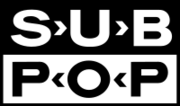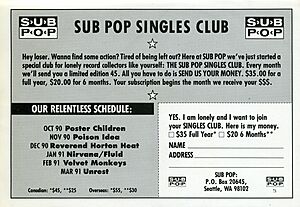Sub Pop facts for kids
Quick facts for kids Sub Pop |
|
|---|---|

We're Not the Best, But We're Pretty Good
|
|
| Parent company | Warner Music Group (49%) |
| Founded | 1986 |
| Founder | Bruce Pavitt, Jonathan Poneman |
| Distributor(s) | ADA (US) Outside Music (Canada) Merlin Network (digital) |
| Genre |
|
| Country of origin | United States |
| Location | Seattle, Washington |
Sub Pop is an independent record label that started in 1986 in Seattle, USA. It was founded by Bruce Pavitt and Jonathan Poneman. Sub Pop became very famous in the early 1990s. This was because they signed popular bands from Seattle like Nirvana, Soundgarden, and Mudhoney. These bands were key players in the grunge music movement. Many people believe Sub Pop helped make grunge music popular.
The label has worked with many other great artists. Some of these include Fleet Foxes, Beach House, The Postal Service, Sleater-Kinney, and Flight of the Conchords. In 1995, the owners of Sub Pop sold a part of the label (49%) to the Warner Music Group.
Contents
History of Sub Pop Records
How Sub Pop Started
The story of Sub Pop began in the early 1980s. Bruce Pavitt created a fanzine (a fan magazine) called Subterranean Pop. This magazine focused on independent record labels in America. Pavitt started this project while he was a student at Evergreen State College.
By the fourth issue, Pavitt shortened the name to Sub Pop. He also started including music tapes of underground rock bands with the magazine. The Sub Pop #5 cassette came out in 1982 and sold two thousand copies. In 1983, Pavitt moved to Seattle, Washington. There, he released the ninth and final issue of Sub Pop. He also wrote a music column for a local magazine called The Rocket.
In 1986, Pavitt released the first Sub Pop LP. It was a collection called Sub Pop 100. It featured music from artists like Sonic Youth and Wipers. The Seattle band Green River chose Sub Pop for their Dry as a Bone EP in 1986. Pavitt couldn't release it until the next year. When it finally came out, Sub Pop promoted it as "ultra-loose grunge."
Also in 1987, Jonathan Poneman gave Sub Pop $20,000. This money helped release the first Soundgarden single. It was called "Hunted Down"/"Nothing to Say." Their first EP, Screaming Life, followed that October. Poneman soon became a full partner in the label. Pavitt focused on finding artists, while Poneman handled the business side. They both wanted the label to focus on "primal rock music."
Creating the "Seattle Sound"
In early 1988, Pavitt and Poneman left their other jobs. They wanted to work on Sub Pop full-time. They raised $43,000 and officially started the company on April 1, 1988. "That money was gone in about thirty days," Pavitt remembered. "We almost went bankrupt after a month."
That August, Sub Pop released the first single by Mudhoney. This band had members from Green River. Sub Pop released Mudhoney's "Touch Me I'm Sick" in a small number of copies. This was done on purpose to make people want it more. Other independent labels later copied this idea.
Pavitt and Poneman studied other successful independent labels. They realized that most big music movements had a local base. They wanted to create a strong identity for Sub Pop. The label's ads promoted Sub Pop itself, not just individual bands. They also wanted to market a "Seattle sound." Producer Jack Endino helped with this. He recorded many songs for Sub Pop between 1987 and 1989. Endino recorded music quickly and cheaply. He used similar studio methods, which gave the records a similar sound.
In November 1988, Sub Pop released "Love Buzz." This was the first single by Nirvana from Aberdeen, Washington. It was the first release for the Sub Pop Singles Club. This was a service where people could subscribe and get new singles by mail every month. At its busiest in 1990, the club had two thousand subscribers.
The club made Sub Pop very important in the Seattle music scene. It made the label's name almost the same as Seattle's music. This was similar to how Motown Records was linked to Detroit. The club also helped Sub Pop earn money. The original club stopped in 1993. A new version, Singles Club V.2, ran from 1998 to 2002.
Some people say Sub Pop helped shape how people saw Seattle's music history. Even in the late 1980s, Seattle bands played many different styles. They mixed folk rock, psychedelic rock, and garage rock. The "Seattle sound" that Sub Pop promoted became known as grunge.
Pavitt and Poneman knew it was hard for small labels to get attention in America. So, they looked to the British music press for help. In March 1989, they flew a journalist from Melody Maker to Seattle. He wrote an article about the local music scene. Just as Pavitt hoped, the British press loved Sub Pop and the grunge sound.
Pavitt said, "I felt that people in Britain and Europe wanted to see something wild. Something that was truly American, drawing from the roots of rock & roll." Poneman explained the label's success: "It could have happened anywhere, but many lucky things happened here. Charles Peterson was here to photograph the scene. Jack Endino was here to record it. Bruce and I were here to share it with the world."
By 1991, Sub Pop was having money problems. This led Mudhoney and Tad to leave the label. It also delayed the release of The Afghan Whigs' album Congregation. A check Sub Pop wrote for Mark Lanegan's recording sessions bounced. This delayed his second album for years.
When Geffen Records bought Nirvana's contract from Sub Pop, it was a big help. Sub Pop received $72,000. It was also agreed that Sub Pop would get a share of the profits from Nirvana's major label album, Nevermind (1991). Future Nirvana albums also had to show the Sub Pop logo next to Geffen's. Nevermind's huge success quickly solved Sub Pop's money problems. Pavitt said, "By Christmas [1991], Nevermind had sold 2 million copies. We went from not being able to pay our phone bill to getting a check for half a million dollars." Sales of Nirvana's album Bleach also helped the label for years.
The success of Nirvana also brought Poneman and Pavitt worldwide attention. They were seen as the "creators of the grunge scene." After grunge became less popular, Poneman started signing different kinds of artists. In 1995, the label made a deal with Warner Bros. Records. Warner Bros. bought 49% of Sub Pop.
Sub Pop After Bruce Pavitt
Poneman and Pavitt had different ideas about the label's future. Poneman wanted the label to grow bigger and earn more money. In 1996, Pavitt left the label. He wanted to spend more time with his family.
The label opened offices around the world. They invested a lot in new artists. But they didn't have huge commercial success. So, they scaled back and returned to Seattle.
In 2006, Sub Pop Records became the first Green-e certified record label. This means they are committed to protecting the environment. They buy enough renewable energy to power their office. This shows their dedication to using clean energy and fighting global warming.
In early 2007, Sub Pop started a sister label called Hardly Art. This label is also partly owned by Warner Music. In August 2008, Sub Pop brought back its singles club for one year. This was to celebrate its twentieth anniversary.
In 2009, they signed their second hip-hop group, Shabazz Palaces from Seattle. The first was The Evil Tambourines in 1999. Ishmael Butler, from Shabazz Palaces, later became an A&R person for Sub Pop. This means he helps find new artists for the label.
Commercial Success
Sub Pop has released many successful albums. Five of their albums have sold over 1 million copies in the US. These are called "platinum" albums by the Recording Industry Association of America. They include:
- Bleach by Nirvana
- Give Up by The Postal Service
- Oh, Inverted World and Wincing the Night Away by The Shins
- Fleet Foxes by Fleet Foxes
Eight albums from Sub Pop have sold over 500,000 copies. These are called "gold" albums. They include:
- Chutes Too Narrow by The Shins
- The Head and the Heart by The Head and the Heart
- Everything All the Time and Cease to Begin by Band of Horses
- Our Endless Numbered Days and The Shepherd's Dog by Iron & Wine
- Depression Cherry by Beach House
- Flight of the Conchords by Flight of the Conchords
Deluxe Editions
Since 2008, Sub Pop has released "Deluxe Editions" of some of its best-selling albums. These special editions include a newly improved version of the album. They also often have extra live songs or demo recordings.
Some albums released as Deluxe Editions include:
- Nirvana’s Bleach
- Mudhoney's Superfuzz Bigmuff
- Sebadoh's Bakesale
- The Postal Service's Give Up
See also
 In Spanish: Sub Pop para niños
In Spanish: Sub Pop para niños
- List of Sub Pop artists
- Lists of record labels


